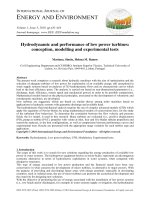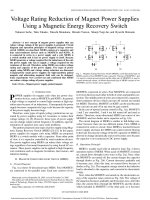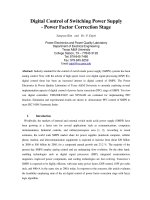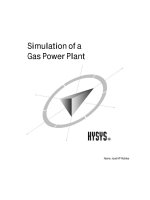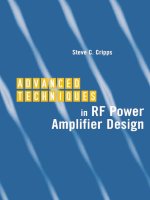feedback linearization of rf power amplifiers
Bạn đang xem bản rút gọn của tài liệu. Xem và tải ngay bản đầy đủ của tài liệu tại đây (5.69 MB, 153 trang )
Feedback Linearization of RF Power
Amplifiers
This page intentionally left blank
FEEDBACK LINEARIZATION OF RF POWER
AMPLIFIERS
JOEL L. DAWSON
Stanford University
THOMAS H. LEE
Stanford University
KLUWER ACADEMIC PUBLISHERS
NEW YORK, BOSTON, DORDRECHT, LONDON, MOSCOW
eBook ISBN: 1-4020-8062-X
Print ISBN:
1-4020-8061-1
©2004 Kluwer Academic Publishers
New York, Boston, Dordrecht, London, Moscow
Print ©2004 Kluwer Academic Publishers
All rights reserved
No part of this eBook may be reproduced or transmitted in any form or by any means, electronic,
mechanical, recording, or otherwise, without written consent from the Publisher
Created in the United States of America
Visit Kluwer Online at:
and Kluwer's eBookstore at:
Boston
To Mari
This page intentionally left blank
Contents
Dedication
List of Figures
List of Tables
Acknowledgments
v
xi
xv
xvii
1. INTRODUCTION
1
1
2
1.1 Motivation
1.2 Organization
2. OPTIMAL ALLOCATION OF LOCAL FEEDBACK IN
MULTISTAGE AMPLIFIERS
2.1 Amplifier stage models
5
6
6
6
8
8
8
9
2.1.1
2.1.2
2.1.3
2.1.4
Linearized static model
Static nonlinear model
Linearized dynamic model
Static noise model
2.2
Amplifier analysis
2.2.1
2.2.2
2.2.3
2.2.4
2.2.5
2.2.6
2.2.7
Gain and output swing
Sensitivity
Nonlinearity
Bandwidth
Delay and rise-time
Noise and dynamic range
SFDR and IIP linearity measures
10
10
11
12
12
13
14
14
15
16
2.3
Geometric programming
2.3.1
2.3.2
Geometric programming in convex form
Solving geometric programs
2.4
Optimal local feedback allocation
viii
FEEDBACK LINEARIZATION OF RF POWER AMPLIFIERS
2.4.1
2.4.2
2.4.3
2.4.4
2.4.5
2.4.6
2.4.7
2.4.8
Closed-loop gain
Maximum signal swing
Sensitivity
Bandwidth
Noise and dynamic range
Delay and rise-time
Third-order distortion
SFDR and IIP3
16
16
17
17
18
18
18
18
18
19
24
25
26
27
28
28
29
30
31
32
33
33
35
35
35
36
37
38
39
39
40
41
43
43
44
44
2.5
Design Examples
2.5.1
2.5.2
2.5.3
Trade-offs among bandwidth, gain, and noise
SFDR versus gain
Stage selection
2.6
2.7
Geometric programming summary
An example application
2.7.1
2.7.2
2.7.3
Linearized static model
Static nonlinear model
Linearized dynamic model
2.7.3.1
2.7.4
An alternative formulation: open-circuit time constants
Static noise model
2.8
Local feedback allocation for power amplifier linearization
3.
THE PROBLEM OF LINEARIZATION
3.1
3.2
3.3
The tradeoff between linearity and power efficiency
Can nonlinear system theory help?
An overview of linearization techniques
3.3.1
3.3.2
3.3.3
3.3.4
3.3.5
3.3.6
3.3.7
3.3.8
Power backoff
Predistortion
Adaptive predistortion
Feedforward
Dynamic biasing
Envelope elimination and restoration
LINC
Cartesian feedback
4.
PHASE ALIGNMENT IN CARTESIAN FEEDBACK SYSTEMS
4.1
Consequences of phase misalignment in Cartesian feedback
systems
4.1.1
4.1.2
Terminology Convention
Impact of phase misalignment on stability
Contents
ix
4.1.3
Compensation for robustness to phase misalignment
46
48
48
50
51
51
52
55
56
57
57
60
61
62
66
66
70
71
78
82
84
88
89
92
93
93
95
99
100
102
102
104
105
4.2
A nonlinear regulator for maintaining phase alignment
4.2.1
4.2.2
4.2.3
4.2.4
Nonlinear dynamical system
Stability concerns
Quadrature error in the mixers
Impact of multiplier offsets
4.3
A new technique for offset-free analog multiplication
4.3.1
Limits on performance
4.4
Summary
5.
A FULLY INTEGRATED CARTESIAN FEEDBACK SYSTEM
5.1
5.2
5.3
5.4
Motivation for pursuing Cartesian feedback
Motivation for a monolithic implementation
CFB IC at the system level
The phase alignment system
5.4.1
Circuit details
5.4.1.1
5.4.1.2
5.4.1.3
5.4.1.4
5.4.1.5
Basic multiplier cell
Phase error computation
An analog integrator
A constant 1-norm controller
Forming the matrix rotation operator
Phase alignment system results
5.4.2
5.5
The linearization circuitry
5.5.1 Circuit details
5.5.1.1
5.5.1.2
5.5.1.3
5.5.1.4
5.5.1.5
5.5.1.6
5.5.1.7
Loop driver
Analog matrix rotation
Upconversion mixer
Power amplifier
Downconverter
Polyphase filters
Constant- biasing
5.5.2
5.5.2.1
5.5.2.2
Linearization system results
Linearization behavior
Loop stability
5.6
Summary
88
x
FEEDBACK LINEARIZATION OF RF POWER AMPLIFIERS
6.
CONCLUSION
6.1
6.2
Summary
Future work
113
113
114
117
117
117
118
118
123
123
123
124
127
133
Appendices
A
The First Prototype of the Phase Alignment Concept
A.1
A.2
A.3
Phase shifter
Phase error and integrator
Test results
B
The Experimental Setup for CFB IC
B.1
B.2
B.3
Single-ended-to-differential conversion
Clock reference
Overview of test board
References
Index
List of Figures
2.1
2.2
2.3
2.4
2.5
2.6
2.7
2.8
2.9
2.10
2.11
2.12
2.13
2.14
2.15
2.16
2.17
3.1
3.2
3.3
Block diagram of multistage amplifier.
Linearized static model of amplifier stage.
Nonlinear static model of amplifier stage.
Linear dynamic model of amplifier stage.
Static noise model of amplifier stage.
Maximum bandwidth versus limit on input-referred noise.
Optimal feedback allocation pattern, for maximum band-
width with limit on input-referred noise. Gain = 23.5dB.
Maximum bandwidth versus required closed-loop gain.
Maximum input-referred noise = 4.15e-7 V rms.
Optimal feedback allocation pattern for maximum band-
width versus required closed-loop gain. Maximum input-
referred noise = 4.15e-7 V rms.
Maximum spurious-free dynamic range versus required gain.
Optimal feedback allocation pattern for maximum spurious-
free dynamic range versus required gain.
CMOS source-coupled pair and differential half-circuit.
Source degeneration as a form of feedback.
Modification for nonlinear static model.
Modeling dynamics using the Miller approximation.
MOSFET noise model.
MOSFET gate and drain noise.
A high-efficiency power amplifier.
Using predistortion to linearize a power amplifier.
An example of adaptive predistortion.
5
7
7
8
9
20
21
22
23
24
25
27
28
29
29
31
31
34
37
37
xii
FEEDBACK LINEARIZATION OF RF POWER AMPLIFIERS
3.4
3.5
3.6
3.7
4.1
4.2
4.3
4.4
4.5
4.6
4.7
4.8
4.9
5.1
5.2
5.3
5.4
5.5
5.6
5.7
5.8
5.9
5.10
5.11
5.12
5.13
5.14
5.15
Feedforward linearization.
Envelope elimination and restoration.
The LINC concept.
Cartesian feedback.
Typical Cartesian feedback system.
Simple feedback system.
Cartesian feedback under 90-degree misalignment.
Root locus plots for dominant-pole and slow-rolloff
compensation.
Rotation of the baseband symbol due to phase misalignment.
Phase alignment concept.
Linearized phase regulation system. ’M’ is the desired
misalignment, which is nominally zero.
New technique for offset-free analog multiplication.
Graphically computing
The predistorting action of Cartesian feedback.
Cartesian feedback used to train a predistorter.
Conceptual diagram of CFB IC.
Phase alignment by phase shifting the local oscillator.
Phase alignment by rotating the baseband symbol.
Analog technique for generating and
Analog rotation using the 1-norm.
Using CMOS voltage switches and a comparator to re-
alize a folding amplifier. Switches are closed when their
respective control signal is high.
Basic topology for multiplier cell. All transistors con-
nected to a input are sized and all transistors
connected to a input are sized
Multiplier cell.
Commutating mixer for chopping. NMOS devices are
sized 3/0.24 , PMOS 9/0.24 .
Phase error computation.
Op-amp_d1, a fully differential op-amp for the S.C. integrator.
Opamp_pL, a single-ended op-amp for low common-
mode inputs.
Opamp_nL, a single-ended op-amp for high common-
mode inputs.
38
39
40
41
44
44
46
47
49
50
51
53
55
58
59
62
63
64
65
65
66
67
69
70
71
72
74
74
List of Figures xiii
5.16
5.17
5.18
5.19
5.20
5.21
5.22
5.23
5.24
5.25
5.26
5.27
5.28
5.29
5.30
5.31
5.32
5.33
5.34
5.35
5.36
5.37
5.38
5.39
5.40
Switched-capacitor, non-inverting integrator for phase
alignment system. Switches are complementary: NMOS
2/0.24 , PMOS 6/0.24 .
Chopping clocks derived from off-chip source.
Integrator clock, which transitions on the trailing edge
of the external 20MHz source.
Circuit for generating clock phases.
Constant 1-norm controller: circuit realization of figure 5.7.
Differential transconductor.
Folding amplifier for constant 1-norm controller.
Computation of the rotation operator.
Overview diagram of phase alignment system.
Phase alignment performance for a 500m V amplitude,
10 kHz square wave.
Effective output offset, of the chopper-stabilized
multipliers of figure 5.12.
Trace capture of a phase alignment experiment. The
Cartesian feedback loop is open.
Illustration of phase alignment stabilizing the closed-
loop CFB system.
Loop driver amplifier.
a circuit to carry out the matrix rotation.
Upconversion mixer. All transistors are sized 2× 50.4/0.24,
all resistors are
Power amplifier.
Potentiometric downconversion mixer, together with bi-
asing and capacitive RF attenuator.
Op-amp_d2, a fully differential op-amp for the down-
conversion mixer.
A two-stage polyphase filter.
A three-stage polyphase filter.
cell, which establishes the voltage ’pbias’
for the entire chip.
Die photo.
Comparison between predistortion inputs and down-
converter outputs for no misalignment.
Comparison between predistortion inputs and down-
converter outputs for 45-degree misalignment.
75
77
78
78
79
80
81
83
84
85
87
88
89
90
92
94
94
96
98
99
100
101
107
108
108
xiv
FEEDBACK LINEARIZATION OF RF POWER AMPLIFIERS
5.41
5.42
5.43
5.44
5.45
5.46
A.1
A.2
A.3
A.4
A.5
A.6
B.1
B.2
B.3
Frequency-domain example of linearization behavior.
Compensation networks used in stability experiments.
Step response of aligned, dominant-pole compensated system.
Step response of aligned, uncompensated system.
Step response of aligned, slow-rolloff compensated system.
Step response comparison between dominant-pole and
slow-rolloff compensated systems for 90-degree misalignment.
Phase shifter.
Phase shifter implementation.
Phase error computation and integration.
Test setup.
Measured phase alignment vs. system drift
Phase alignment vs. baseband frequency
Converting from single-ended to differential signals.
The on-board clock reference.
The test board.
109
109
110
110
111
111
117
118
119
119
120
121
124
124
125
List of Tables
2.1
5.1
5.2
5.3
5.4
5.5
5.6
5.7
5.8
5.9
5.10
5.11
5.12
5.13
5.14
5.15
5.16
5.17
5.18
A.1
Candidate stages.
Multiplier elements.
Phase error computation elements. Quiescent current
includes current draw of multiplier cells.
Elements for integrator op-amp. Quiescent current in-
cludes current draw of Opamp_nL and Opamp_pL.
Opamp_pL elements.
Opamp_nL elements.
Integrator capacitor values.
Elements for chopping clocks.
Constant 1-norm elements. Quiescent current includes
current draw of folding amplifier and cells.
Differential transconductor elements.
Folding amplifier elements.
Rotation operator elements.
Elements for loop driver amplifier. Quiescent current
includes current draw of Opamp_nL and Opamp_pL.
Matrix rotation operator elements.
Power amplifier elements.
Downconversion mixer elements. Quiescent current in-
cludes current draw of Op-amp_d2.
Elements for downconversion op-amp.
Polyphase filter elements.
bias cell elements.
Comparison with examples from the literature.
26
69
70
72
73
75
75
77
79
80
82
84
91
93
95
96
98
100
101
120
This page intentionally left blank
Acknowledgments
It is with great pleasure that we acknowledge the many people who have
supported the work described in this book. In particular‚ Professor Stephen
Boyd deserves credit for originally proposing the investigation of Chapter 2‚
and for working closely with us to bring it to fruition. Professors Bruce Wooley
and Donald Cox graciously read a draft of this entire manuscript‚ and provided
valuable and insightful comments.
We would also like to thank a number of institutions for their support of this
investigation. Lucent Technologies‚ the National Science Foundation‚ and the
Hertz Foundation all provided fellowship support‚ as did Stanford University
through its Stanford Graduate Fellows program. National Semiconductor con-
tinues to provide Stanford students with free use of its 0.25
µ
m CMOS process‚
an almost unbelievable luxury for students in our field. Agilent Technologies
supported this work through the FMA program at CIS. This was largely due
to the efforts of Dr. Jim Hollenhorst and Paul Corredoura‚ who in addition
provided friendship and were sources of stimulating technical discussion.
Stanford’s Center for Integrated Systems was a wonderful place to work‚ and
this was due in large part to the presence of its graduate students. Dr. Daw-
son gladly acknowledges all members‚ past and present‚ of the Lee (SMIrC)‚
Wooley‚ and Wong groups who have given their friendship and collaboration.
Dr. David Su‚ formerly of the Wooley group‚ was particularly generous with
his advice and insight during the hardware testing stages of this investigation.
Ann Guerra‚ the administrative assistant to Professors Lee and Wooley‚ has
been a marvel at making administrative tasks run smoothly. She does this with
a warmth‚ kindness‚ and humor that have greatly eased the passage of many
students through the Ph.D. program. We take this opportunity to thank her for
being a wonderful person to work with.
Dr. Dawson would also like to acknowledge his family‚ which was a source
of unending love and support. They showed him that he is not‚ and never
has been‚ alone in his endeavors. Finally, Marisol Negrón deserves a special
xviii
FEEDBACK LINEARIZATION OF RF POWER AMPLIFIERS
acknowledgment for her steadfast love and support during the toughest days of
this investigation. It is only fitting that this book be dedicated to her.
Chapter 1
INTRODUCTION
Research activity in the area of radio-frequency (RF) circuit design has surged
in the last decade in direct response to the enormous market demand for inex-
pensive, portable, high data rate wireless transceivers. Our expectations for
such transceivers, such as cellular phones, rise as they become seemingly ubiq-
uitous. Once, the simple fact of a fairly reliable wireless voice connection
was sufficient and even exciting. Now, crystal-clear voice with no lapses in
coverage is actively sought, together with the capability to act as a web portal
and even a digital assistant. All of this must be accomplished by a device that
is cheap enough to be virtually given away, small enough to justify the claim
of portability, and frugal enough with power demands to last a long time on a
single battery charge.
Cellular phones are just one example of a market that has spurred recent
research activity. Wireless local-area networks (WLAN’s) are another relatively
new application of RF circuit techniques, as is the popular Global Positioning
System (GPS). Meeting this demand for a kind of general connectivity involves
a host of fascinating technical challenges. Among these, many are associated
with the power amplifier, the system block that drives the antenna in any radio
transmitter.
1.1
Motivation
If the objective is an inexpensive, portable, high-performance transceiver,
the desirability of certain circuit characteristics is clear. A low-cost solution is
likely to be one in which as many circuit blocks as possible are implemented on
the same chip: the cost savings result from the simplified PC (printed circuit)
board. An inexpensive IC (integrated circuit) process, such as CMOS, translates
directly into a cost savings. Portability implies at least two things from a
circuit standpoint: small size, which is another advantage of a highly integrated
2
FEEDBACK LINEARIZATION OF RF POWER AMPLIFIERS
solution, and a long battery lifetime. Long battery lifetimes motivate low-power
circuit techniques, so we add low power dissipation to the growing list of design
constraints. What is meant by “high-performance” depends on the context. For
purposes of this book, high-performance implies the ability to communicate at
the highest data rate possible for a given channel bandwidth. Achieving this
goal directs the system designer to linear modulation techniques, and the circuit
designer to a means of achieving high linearity in the transmitter.
A transceiver’s performance according to the metrics of degree of integra-
tion, power consumption, and transmitter linearity is usually dominated by the
performance of the power amplifier. At even modest output powers (a few
hundred milliwatts) it is far and away the most power-hungry system block in a
transceiver, and the large voltage swings at its output push it deep into nonlin-
ear regions of operation. The devices in most IC processes impose a maximum
usable DC power supply voltage. Further, high-Q impedance transformations,
which cannot always be realized on-chip, are sometimes necessary to achieve
high output power levels.
It follows that improvements in transmitter performance depend on the progress
made with the power amplifier. That observation motivates the investigation
described in this book.
1.2
Organization
The arc of this text generally proceeds from the abstract to the applied,
culminating with a description of a fabricated chip designed to tie together many
of the concepts treated here. Chapter 2 deals with the theoretical problem of
realizing amplification with a cascade of stages. One design option is to employ
local feedback around each of the individual stages. This chapter details the
surprising result that a wide range of specifications, including linearity, can be
optimized through intelligent choice of the feedback gains. That an optimum
exists is perhaps not a surprise, but that this optimum can be found quickly
and unambiguously is new and of considerable interest. The key is a technique
called geometric programming.
The importance of linearity in radio transmitters is treated briefly in Chap-
ter 3, together with a description of the tradeoff between linearity and power
efficiency in power amplifiers. This chapter is also an exploration of the various
common methods of softening this tradeoff, which can be grouped under the
general heading of “linearization techniques.”
Chapter 4 describes a new approach for achieving and maintaining phase
alignment in Cartesian feedback power amplifiers. The focus here is on the
theoretical principles of the new method, which during the investigation were
validated by simulation and by a discrete-component prototype. A new tech-
nique for realizing accurate analog multiplication is developed as a means of
Introduction
3
improving the performance of the first prototype. A full analysis of this multi-
plication technique is presented here.
This book concludes with Chapter 5, a description of the culminating IC
prototype, and Chapter 6, final thoughts. Readers interested in further details
of the hardware prototypes are directed to the appendices.
This page intentionally left blank
Chapter 2
OPTIMAL ALLOCATION OF LOCAL FEEDBACK
IN MULTISTAGE AMPLIFIERS
The use of linear feedback around an amplifier stage was pioneered by
Black [1], Bode [2], and others. The relations among the choice of feedback
gain and the (closed-loop) gain, bandwidth, rise-time, sensitivity, noise, and
distortion properties, are well understood (see, e.g., [3]). For a single stage
amplifier, the choice of the (single) feedback gain is a simple problem.
In this chapter we consider the multistage amplifier shown in figure 2.1,
consisting of open-loop amplifier stages denoted with local
feedback gains employed around the stages.
1
We assume that the amplifier stages are fixed, and consider the problem of
choosing the feedback gains The choice of these feedback gains af-
fects a wide variety of performance measures for the overall amplifier, including
gain, bandwidth, rise-time, delay, noise, distortion and sensitivity properties,
maximum output swing, and dynamic range. These performance measures de-
pend on the feedback gains in a complicated and nonlinear manner. It is thus
1
Much of the material presented in this chapter originally appeared in the journal article [4], written by the
author and coauthored by S. Boyd, M. Hershenson, and T. H. Lee.
6
FEEDBACK LINEARIZATION OF RF POWER AMPLIFIERS
far from clear, given a set of specifications, how to find an optimal choice of
feedback gains. We refer to the problem of determining optimal values of the
feedback gains, for a given set of specifications on overall amplifier perfor-
mance, as the local feedback allocation problem.
We will show that the local feedback allocation problem can be cast as a
geometric program (GP), which is a special type of optimization problem. Even
complicated geometric programs can be solved very efficiently, and globally, by
recently developed interior-point methods (see [5, 6,7]). Therefore we are able
to give a complete, global, and efficient solution to the local feedback allocation
problem.
In section 2.1, we give a detailed description of the models of an amplifier
stage used to analyze the performance of the amplifier. Though simple, the
models capture the basic qualitative behavior of a source-degenerated differ-
ential pair. In section 2.2, we derive expressions for the various performance
measures for the overall amplifier, in terms of the local feedback gains. In
section 2.3, we give a brief description of geometric programming, and in sec-
tion 2.4, we put it all together to show how the optimal local feedback allocation
problem can be cast as a geometric program, and design examples are given
in section 2.5. A summary of the method follows in section 2.6, along with a
treatment of a specific circuit example in section 2.7. This chapter closes with
section 2.8, a discussion of the relevance of local feedback allocation to power
amplifier linearization.
2.1
Amplifier stage models
In this section we describe several different models of an amplifier stage,
used for various types of analysis.
2.1.1
Linearized static model
The simplest model we use is the linear static model shown in figure 2.2.
The stage is characterized by where is the gain of the stage,
which we assume to be positive. We will use this simple model for determining
the overall gain of the amplifier, determining the maximum signal swing, and
the sensitivity of the amplifier gain to each stage gain.
2.1.2
Static nonlinear model
To quantify nonlinear distortion effects, we use a static nonlinear model of
the amplifier stage as shown in figure 2.3. We assume that the nonlinearity or
transfer characteristic has the form

